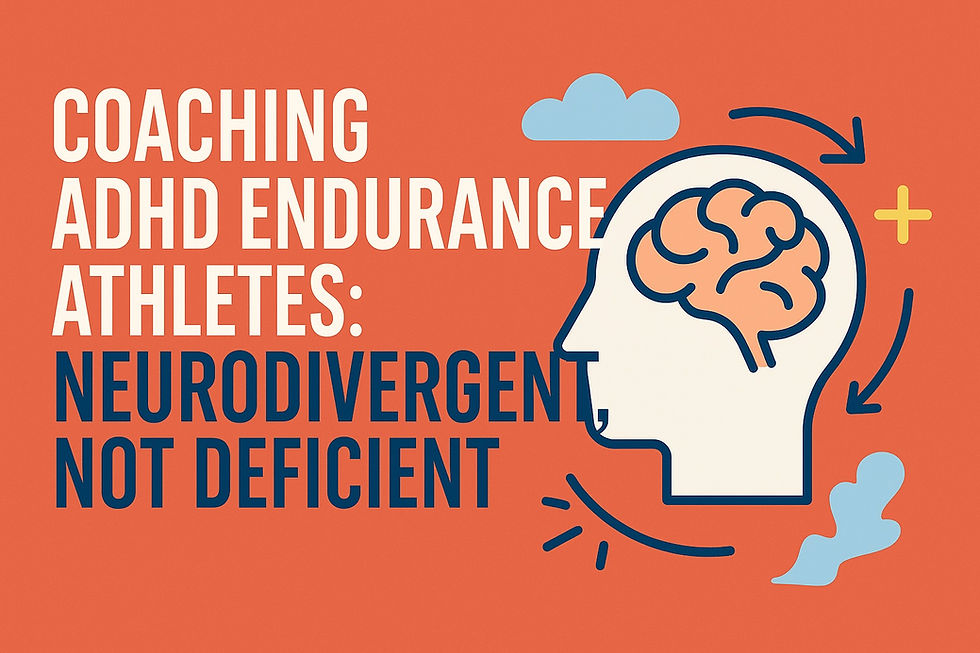Coaching ADHD Athletes: Neurodivergent, Not Deficient
- Austin Wheat

- May 5
- 4 min read
By Austin Wheat, Dr. Whitley Atkins

Austin’s Story
I was always an outside kid, drawn to sports, adventure, and curiosity. What I didn’t realize at the time was that I had an interest-driven brain.
In 2007, I was diagnosed with ADHD and labeled as gifted. I didn’t fully understand what either meant. I took the medication prescribed, followed instructions, and moved forward.
For nearly a decade, I was on 144 mg of extended-release Methylphenidate, roughly twice the current recommended maximum dose. I felt numb and disconnected from myself.
Eventually, I stopped taking it. I was hungry again. I felt emotion again. I felt more like myself. But I still struggled. Executive dysfunction, time blindness, and emotional volatility made everyday life hard to manage. Years later, I was re-evaluated. With a new approach, a lower dose, and support from a therapist, I finally found clarity. Life stopped feeling like a constant fight against my own brain, and I stopped blaming myself for not fitting into spaces that weren’t built for me.
Whitley’s Story
Like Austin, I was an active, curious kid who loved sports and the outdoors. I was labeled as gifted in middle school, though I now think “neurodivergent” is a better descriptor. School came easy until college. My impulsive brain constantly found distractions. I didn’t know how to study and struggled to focus. After a rough freshman year, I buckled down, but it always felt like I had to work much harder than others just to stay on track.
In graduate school, the pattern continued. I’d bomb one exam, hyperfocus, and ace the next. I later recognized this as dopamine-seeking behavior. I also dealt with emotional swings, anxiety, and impulsive decisions in my personal life. At 25, I was diagnosed with ADHD.
Today, I work with a psychiatrist and therapist who specialize in ADHD. I aim to use the lowest dose possible, and I often lean on behavioral tools to help me adapt, especially during transitions or in high-demand environments. Medication has supported me through my postdoc and into a new faculty role, but structure and self-awareness are just as important.
The Link Between ADHD and Endurance Sports
There is a strong connection between ADHD and endurance sports. The structure, repetitive motion, and physical stimulation help regulate dopamine, focus, and mood. If you're coaching endurance athletes, it's very likely you've coached someone with ADHD.
Important note about medication
Stimulants, like Adderall or Ritalin, are allowed out of competition but are prohibited in-competition under WADA/USADA rules. Athletes using them must submit a Therapeutic Use Exemption (TUE) if they want to compete legally.
Nutrition, Hydration, and Medication
Athletes using stimulant medication need to be intentional about fueling and hydration. Stimulants can suppress appetite and act as diuretics, which increases the risk of under-fueling and dehydration - especially in hot conditions. Planning meals around medication timing and including electrolytes throughout the day can make a big difference.
I’ve found that simple tools like setting phone alarms or using daily checklists help ensure I eat and hydrate consistently, even when I’m not hungry.
What ADHD Can Look Like in Athletes and What We Can Do
ADHD is more than distraction. It affects executive function, emotional regulation, circadian rhythm, and impulse control. The condition is often misunderstood, yet the challenges are real. According to Cambridge University Press, ADHD reduces life expectancy by 6.78 years in men and 8.64 years in women. This is due to higher rates of depression, anxiety, substance abuse, sleep issues, injury, and chronic health problems - often worsened by inconsistent care.
For many athletes, the biggest challenges aren’t physical but executive. I’ve forgotten my watch, helmet, swimsuit, and nutrition - often realizing too late. Preparing gear the night before and using checklists helps reduce stress and avoid last-minute chaos. Simplifying transitions from home to training cuts down on decision fatigue and helps me stay consistent.
Morning workouts can be especially tough, particularly for those with varying chronotypes. By the time afternoon rolls around, the world is in transition - emails, family, work – and executive dysfunction often kicks in. Planning exactly when and where to train provides just enough structure to follow through without overwhelming myself. I also build in small, healthy rewards like a post-session smoothie or a favorite playlist to tap into the dopamine-seeking brain without creating unhealthy habits.
Another common challenge is maintaining focus on long-term goals. Whitley shared that sticking to a training plan six to eight months out is especially difficult. Like many ADHDers, she thrives under pressure and works incredibly well up against a deadline - but that doesn't translate neatly into endurance sports, where progress depends on slow, steady, often boring consistency. When she raced four to five 70.3s a year, it was easier to stay locked in with a race always on the horizon. Now, she’s still experimenting with ways to create reward-based systems to stay engaged between major events. This might mean adding more frequent, shorter races, simulating key efforts, or building in tangible rewards like new gear. Coaches and athletes alike should explore ways to keep motivation alive through short-term wins that build toward long-term success.
Still, when ADHD athletes are supported, they thrive. I’ve seen athletes enter deep focus on technical descents where others fade. In chaotic races, they adapt quickly – troubleshooting gear issues or adjusting pacing on the fly. Their energy becomes an advantage late in long events. Many also pick up on patterns in terrain and group dynamics quickly, making them highly collaborative teammates. With the right environment, ADHD athletes don’t just participate - they lead.
ADHD isn’t something to control, it’s something to understand. What looks like chaos is often untapped potential, and with the right tools, that potential becomes power.
This message matters. Pass it on.





























Comments